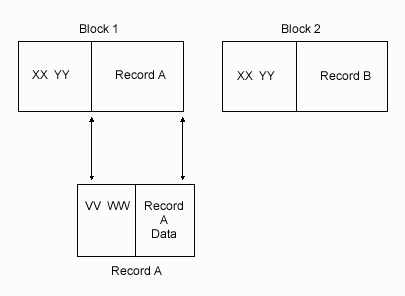This is an example of record format *V, which consists of a graphic with an explanation.
Variable-length, deblocked, unspanned (*V).
XX and YY make up the BDW. XX is the length of the record plus the length of the BDW (4 bytes). YY represents currently reserved fields and must be 00. XX should be the actual length of the data block that is written.
Record A has its own mapping by including the RDW. VV and WW make up the RDW. VV is the length of the record plus the length of the RDW (4 bytes). WW are currently reserved fields and must be 00. VV should be the actual block length (the value in XX) minus 4 bytes (size of BDW). i5/OS™ will pad blocks to make the 18-byte block limit. This occurs if the record data is less than 10 bytes (10 bytes plus 8 bytes of header information is the 18-byte block limit). i5/OS will pad the block with a byte of X'80' followed by bytes of X'00'.
